Commercial Law Case Study: Negligence Analysis - Duty of Care, Breach
VerifiedAdded on 2019/10/30
|8
|1499
|462
Case Study
AI Summary
This case study analyzes a negligence scenario in commercial law. The assignment addresses whether a duty of care was owed by Michelle to Rebecca, examining the principles of proximity, reasonable foreseeability, and justness. It then assesses if Michelle breached this duty by driving while intoxicated, causing an accident and Rebecca's injuries. The analysis further explores causation, determining if Rebecca's injuries were a direct result of Michelle's actions and not too remote. Finally, the case considers potential defenses for Michelle, including contributory negligence and voluntary assumption of risk, referencing relevant legal precedents such as *Caparo Industries plc v Dickman*, *Donoghue v Stevenson*, *Overseas Tankship (UK) Ltd v Morts Dock and Engineering Co Ltd*, *Froom v Butcher*, and *Insurance Commissioner v Joyce* to support the conclusions.
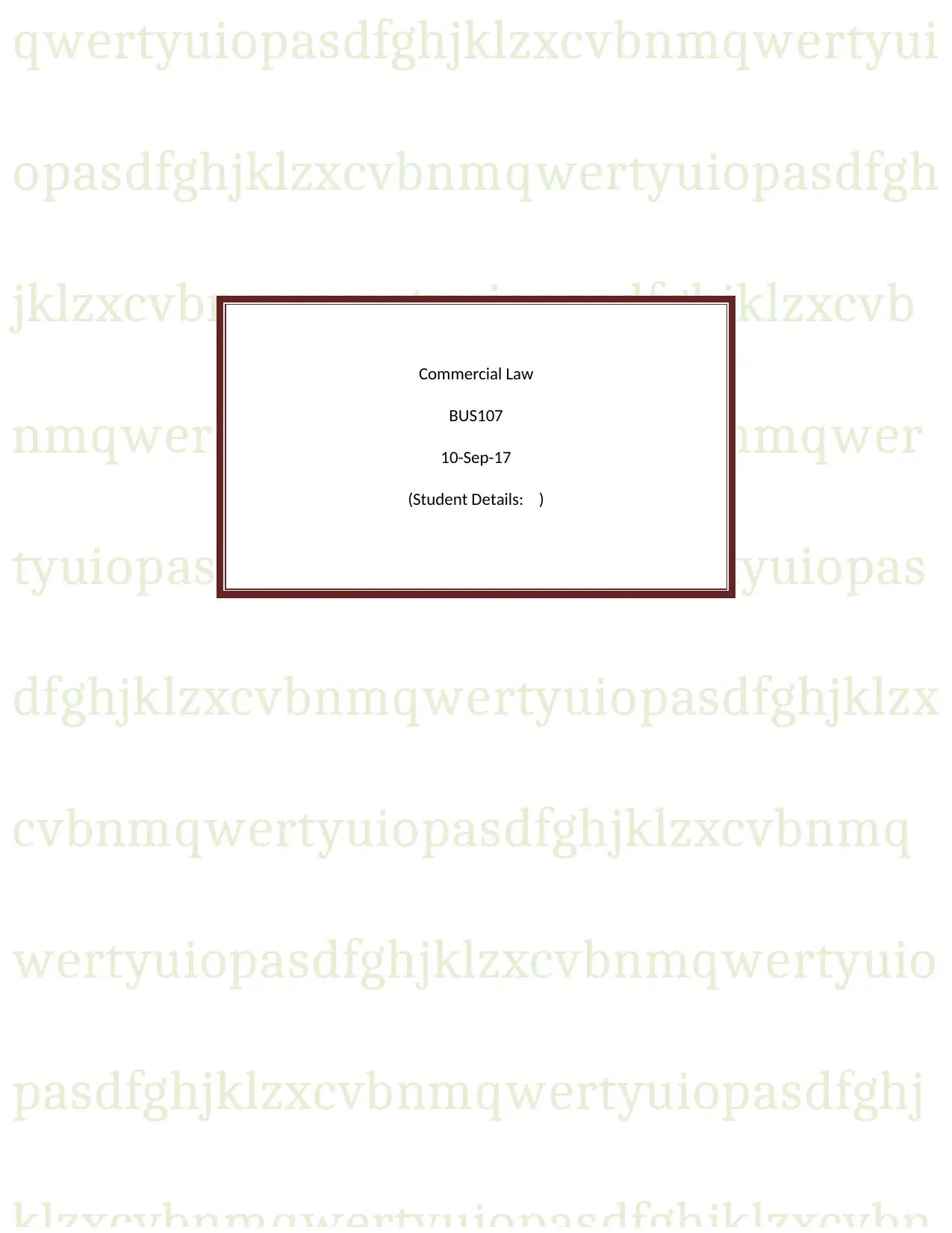
qwertyuiopasdfghjklzxcvbnmqwertyui
opasdfghjklzxcvbnmqwertyuiopasdfgh
jklzxcvbnmqwertyuiopasdfghjklzxcvb
nmqwertyuiopasdfghjklzxcvbnmqwer
tyuiopasdfghjklzxcvbnmqwertyuiopas
dfghjklzxcvbnmqwertyuiopasdfghjklzx
cvbnmqwertyuiopasdfghjklzxcvbnmq
wertyuiopasdfghjklzxcvbnmqwertyuio
pasdfghjklzxcvbnmqwertyuiopasdfghj
Commercial Law
BUS107
10-Sep-17
(Student Details: )
opasdfghjklzxcvbnmqwertyuiopasdfgh
jklzxcvbnmqwertyuiopasdfghjklzxcvb
nmqwertyuiopasdfghjklzxcvbnmqwer
tyuiopasdfghjklzxcvbnmqwertyuiopas
dfghjklzxcvbnmqwertyuiopasdfghjklzx
cvbnmqwertyuiopasdfghjklzxcvbnmq
wertyuiopasdfghjklzxcvbnmqwertyuio
pasdfghjklzxcvbnmqwertyuiopasdfghj
Commercial Law
BUS107
10-Sep-17
(Student Details: )
Paraphrase This Document
Need a fresh take? Get an instant paraphrase of this document with our AI Paraphraser
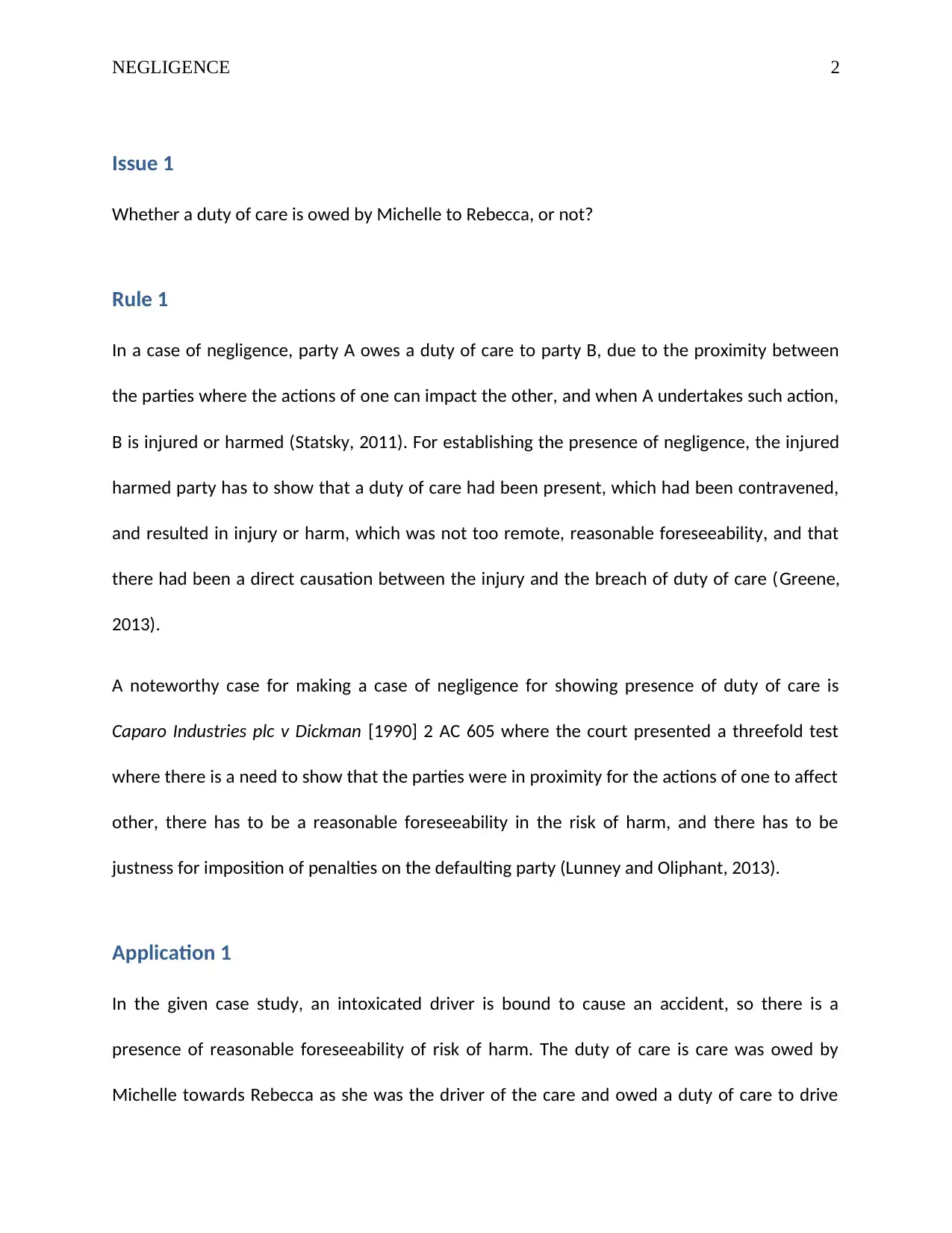
NEGLIGENCE 2
Issue 1
Whether a duty of care is owed by Michelle to Rebecca, or not?
Rule 1
In a case of negligence, party A owes a duty of care to party B, due to the proximity between
the parties where the actions of one can impact the other, and when A undertakes such action,
B is injured or harmed (Statsky, 2011). For establishing the presence of negligence, the injured
harmed party has to show that a duty of care had been present, which had been contravened,
and resulted in injury or harm, which was not too remote, reasonable foreseeability, and that
there had been a direct causation between the injury and the breach of duty of care (Greene,
2013).
A noteworthy case for making a case of negligence for showing presence of duty of care is
Caparo Industries plc v Dickman [1990] 2 AC 605 where the court presented a threefold test
where there is a need to show that the parties were in proximity for the actions of one to affect
other, there has to be a reasonable foreseeability in the risk of harm, and there has to be
justness for imposition of penalties on the defaulting party (Lunney and Oliphant, 2013).
Application 1
In the given case study, an intoxicated driver is bound to cause an accident, so there is a
presence of reasonable foreseeability of risk of harm. The duty of care is care was owed by
Michelle towards Rebecca as she was the driver of the care and owed a duty of care to drive
Issue 1
Whether a duty of care is owed by Michelle to Rebecca, or not?
Rule 1
In a case of negligence, party A owes a duty of care to party B, due to the proximity between
the parties where the actions of one can impact the other, and when A undertakes such action,
B is injured or harmed (Statsky, 2011). For establishing the presence of negligence, the injured
harmed party has to show that a duty of care had been present, which had been contravened,
and resulted in injury or harm, which was not too remote, reasonable foreseeability, and that
there had been a direct causation between the injury and the breach of duty of care (Greene,
2013).
A noteworthy case for making a case of negligence for showing presence of duty of care is
Caparo Industries plc v Dickman [1990] 2 AC 605 where the court presented a threefold test
where there is a need to show that the parties were in proximity for the actions of one to affect
other, there has to be a reasonable foreseeability in the risk of harm, and there has to be
justness for imposition of penalties on the defaulting party (Lunney and Oliphant, 2013).
Application 1
In the given case study, an intoxicated driver is bound to cause an accident, so there is a
presence of reasonable foreseeability of risk of harm. The duty of care is care was owed by
Michelle towards Rebecca as she was the driver of the care and owed a duty of care to drive
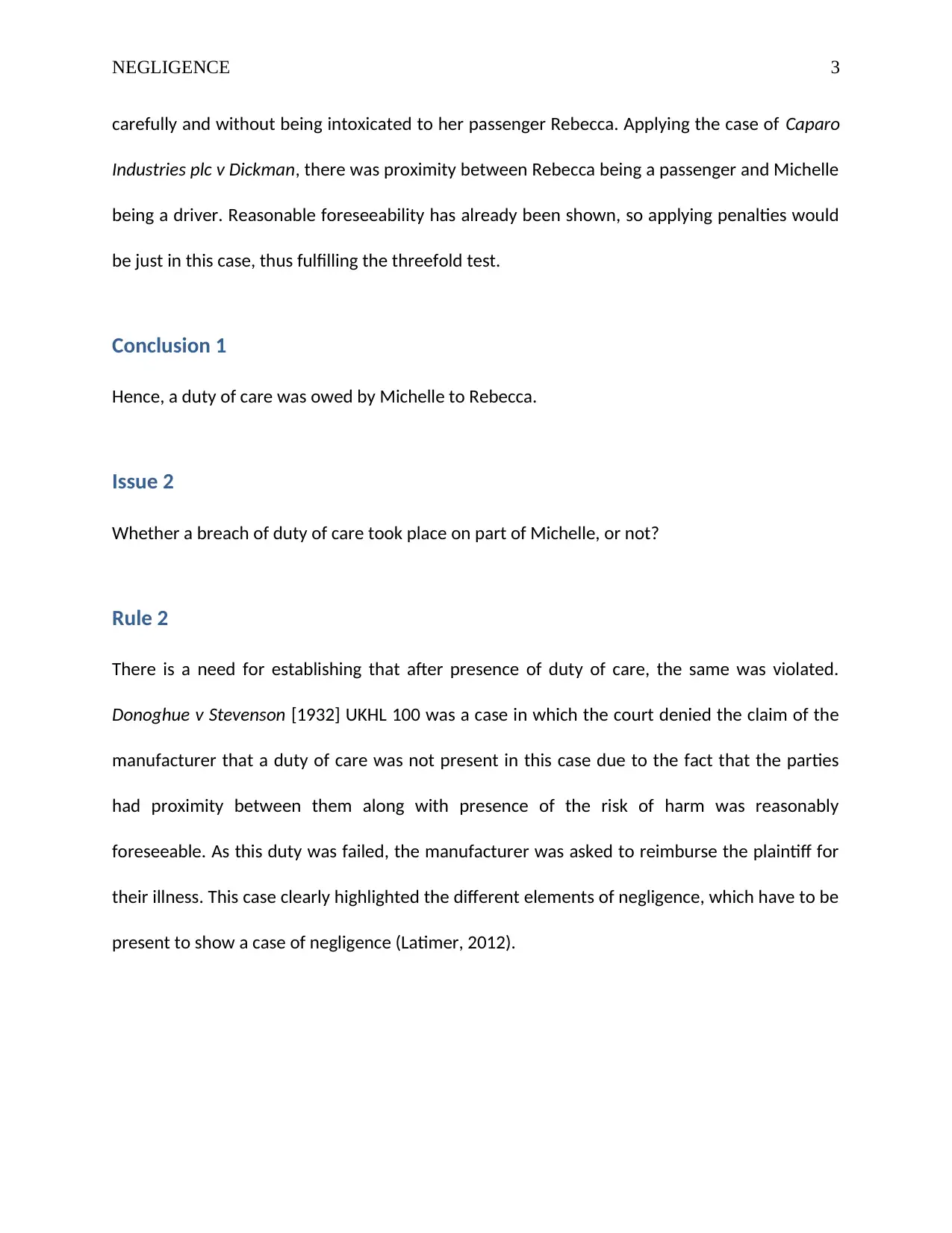
NEGLIGENCE 3
carefully and without being intoxicated to her passenger Rebecca. Applying the case of Caparo
Industries plc v Dickman, there was proximity between Rebecca being a passenger and Michelle
being a driver. Reasonable foreseeability has already been shown, so applying penalties would
be just in this case, thus fulfilling the threefold test.
Conclusion 1
Hence, a duty of care was owed by Michelle to Rebecca.
Issue 2
Whether a breach of duty of care took place on part of Michelle, or not?
Rule 2
There is a need for establishing that after presence of duty of care, the same was violated.
Donoghue v Stevenson [1932] UKHL 100 was a case in which the court denied the claim of the
manufacturer that a duty of care was not present in this case due to the fact that the parties
had proximity between them along with presence of the risk of harm was reasonably
foreseeable. As this duty was failed, the manufacturer was asked to reimburse the plaintiff for
their illness. This case clearly highlighted the different elements of negligence, which have to be
present to show a case of negligence (Latimer, 2012).
carefully and without being intoxicated to her passenger Rebecca. Applying the case of Caparo
Industries plc v Dickman, there was proximity between Rebecca being a passenger and Michelle
being a driver. Reasonable foreseeability has already been shown, so applying penalties would
be just in this case, thus fulfilling the threefold test.
Conclusion 1
Hence, a duty of care was owed by Michelle to Rebecca.
Issue 2
Whether a breach of duty of care took place on part of Michelle, or not?
Rule 2
There is a need for establishing that after presence of duty of care, the same was violated.
Donoghue v Stevenson [1932] UKHL 100 was a case in which the court denied the claim of the
manufacturer that a duty of care was not present in this case due to the fact that the parties
had proximity between them along with presence of the risk of harm was reasonably
foreseeable. As this duty was failed, the manufacturer was asked to reimburse the plaintiff for
their illness. This case clearly highlighted the different elements of negligence, which have to be
present to show a case of negligence (Latimer, 2012).
⊘ This is a preview!⊘
Do you want full access?
Subscribe today to unlock all pages.

Trusted by 1+ million students worldwide
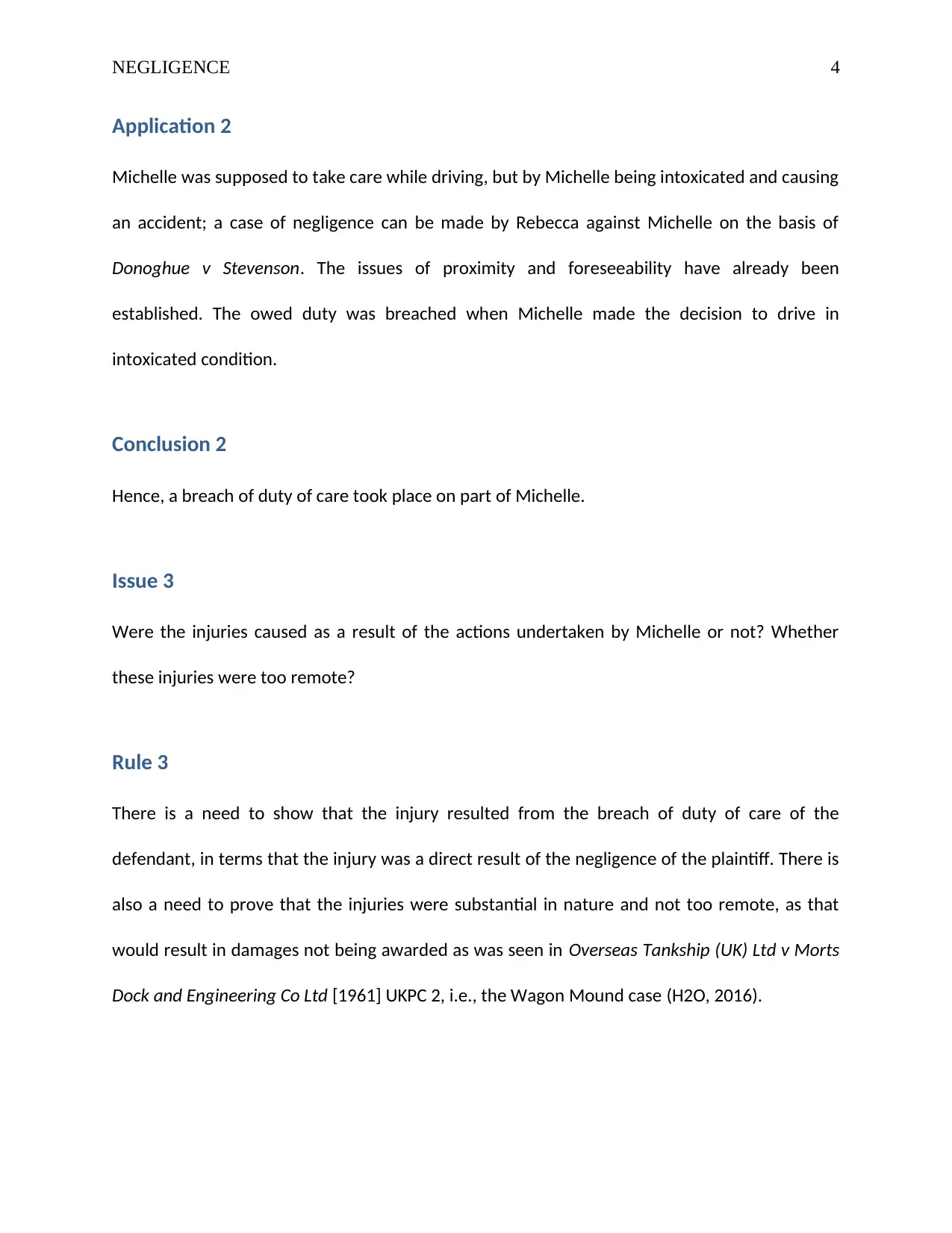
NEGLIGENCE 4
Application 2
Michelle was supposed to take care while driving, but by Michelle being intoxicated and causing
an accident; a case of negligence can be made by Rebecca against Michelle on the basis of
Donoghue v Stevenson. The issues of proximity and foreseeability have already been
established. The owed duty was breached when Michelle made the decision to drive in
intoxicated condition.
Conclusion 2
Hence, a breach of duty of care took place on part of Michelle.
Issue 3
Were the injuries caused as a result of the actions undertaken by Michelle or not? Whether
these injuries were too remote?
Rule 3
There is a need to show that the injury resulted from the breach of duty of care of the
defendant, in terms that the injury was a direct result of the negligence of the plaintiff. There is
also a need to prove that the injuries were substantial in nature and not too remote, as that
would result in damages not being awarded as was seen in Overseas Tankship (UK) Ltd v Morts
Dock and Engineering Co Ltd [1961] UKPC 2, i.e., the Wagon Mound case (H2O, 2016).
Application 2
Michelle was supposed to take care while driving, but by Michelle being intoxicated and causing
an accident; a case of negligence can be made by Rebecca against Michelle on the basis of
Donoghue v Stevenson. The issues of proximity and foreseeability have already been
established. The owed duty was breached when Michelle made the decision to drive in
intoxicated condition.
Conclusion 2
Hence, a breach of duty of care took place on part of Michelle.
Issue 3
Were the injuries caused as a result of the actions undertaken by Michelle or not? Whether
these injuries were too remote?
Rule 3
There is a need to show that the injury resulted from the breach of duty of care of the
defendant, in terms that the injury was a direct result of the negligence of the plaintiff. There is
also a need to prove that the injuries were substantial in nature and not too remote, as that
would result in damages not being awarded as was seen in Overseas Tankship (UK) Ltd v Morts
Dock and Engineering Co Ltd [1961] UKPC 2, i.e., the Wagon Mound case (H2O, 2016).
Paraphrase This Document
Need a fresh take? Get an instant paraphrase of this document with our AI Paraphraser
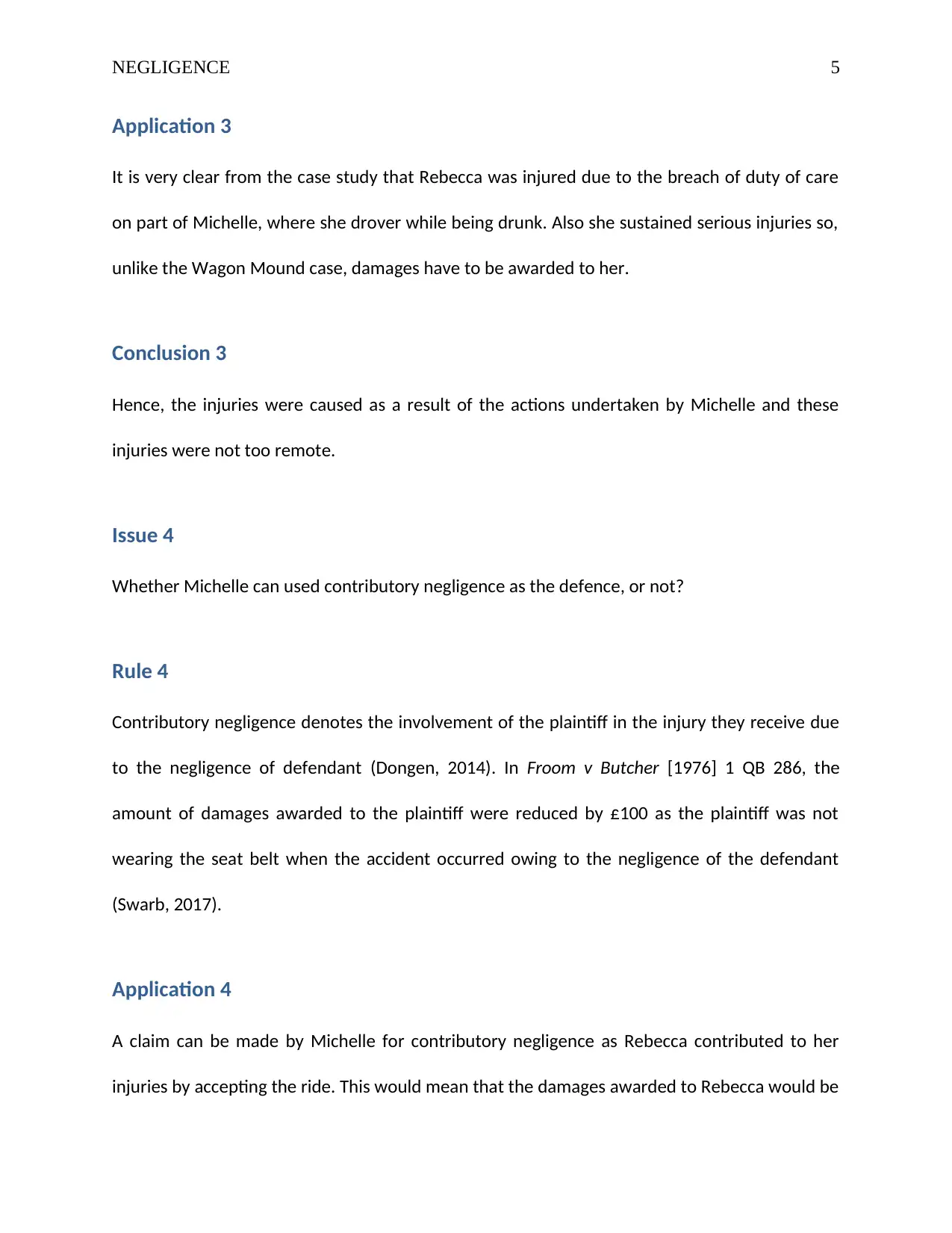
NEGLIGENCE 5
Application 3
It is very clear from the case study that Rebecca was injured due to the breach of duty of care
on part of Michelle, where she drover while being drunk. Also she sustained serious injuries so,
unlike the Wagon Mound case, damages have to be awarded to her.
Conclusion 3
Hence, the injuries were caused as a result of the actions undertaken by Michelle and these
injuries were not too remote.
Issue 4
Whether Michelle can used contributory negligence as the defence, or not?
Rule 4
Contributory negligence denotes the involvement of the plaintiff in the injury they receive due
to the negligence of defendant (Dongen, 2014). In Froom v Butcher [1976] 1 QB 286, the
amount of damages awarded to the plaintiff were reduced by £100 as the plaintiff was not
wearing the seat belt when the accident occurred owing to the negligence of the defendant
(Swarb, 2017).
Application 4
A claim can be made by Michelle for contributory negligence as Rebecca contributed to her
injuries by accepting the ride. This would mean that the damages awarded to Rebecca would be
Application 3
It is very clear from the case study that Rebecca was injured due to the breach of duty of care
on part of Michelle, where she drover while being drunk. Also she sustained serious injuries so,
unlike the Wagon Mound case, damages have to be awarded to her.
Conclusion 3
Hence, the injuries were caused as a result of the actions undertaken by Michelle and these
injuries were not too remote.
Issue 4
Whether Michelle can used contributory negligence as the defence, or not?
Rule 4
Contributory negligence denotes the involvement of the plaintiff in the injury they receive due
to the negligence of defendant (Dongen, 2014). In Froom v Butcher [1976] 1 QB 286, the
amount of damages awarded to the plaintiff were reduced by £100 as the plaintiff was not
wearing the seat belt when the accident occurred owing to the negligence of the defendant
(Swarb, 2017).
Application 4
A claim can be made by Michelle for contributory negligence as Rebecca contributed to her
injuries by accepting the ride. This would mean that the damages awarded to Rebecca would be
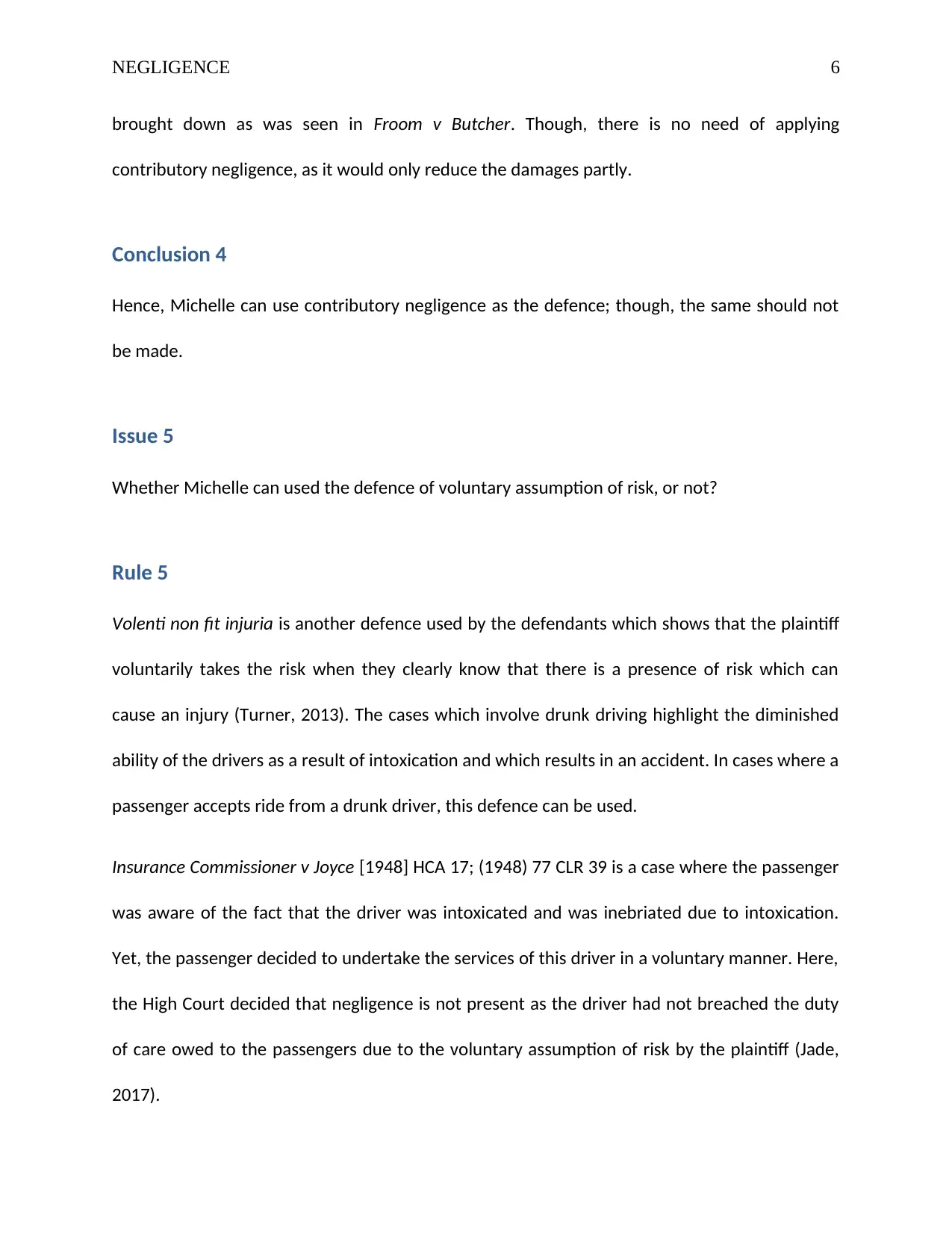
NEGLIGENCE 6
brought down as was seen in Froom v Butcher. Though, there is no need of applying
contributory negligence, as it would only reduce the damages partly.
Conclusion 4
Hence, Michelle can use contributory negligence as the defence; though, the same should not
be made.
Issue 5
Whether Michelle can used the defence of voluntary assumption of risk, or not?
Rule 5
Volenti non fit injuria is another defence used by the defendants which shows that the plaintiff
voluntarily takes the risk when they clearly know that there is a presence of risk which can
cause an injury (Turner, 2013). The cases which involve drunk driving highlight the diminished
ability of the drivers as a result of intoxication and which results in an accident. In cases where a
passenger accepts ride from a drunk driver, this defence can be used.
Insurance Commissioner v Joyce [1948] HCA 17; (1948) 77 CLR 39 is a case where the passenger
was aware of the fact that the driver was intoxicated and was inebriated due to intoxication.
Yet, the passenger decided to undertake the services of this driver in a voluntary manner. Here,
the High Court decided that negligence is not present as the driver had not breached the duty
of care owed to the passengers due to the voluntary assumption of risk by the plaintiff (Jade,
2017).
brought down as was seen in Froom v Butcher. Though, there is no need of applying
contributory negligence, as it would only reduce the damages partly.
Conclusion 4
Hence, Michelle can use contributory negligence as the defence; though, the same should not
be made.
Issue 5
Whether Michelle can used the defence of voluntary assumption of risk, or not?
Rule 5
Volenti non fit injuria is another defence used by the defendants which shows that the plaintiff
voluntarily takes the risk when they clearly know that there is a presence of risk which can
cause an injury (Turner, 2013). The cases which involve drunk driving highlight the diminished
ability of the drivers as a result of intoxication and which results in an accident. In cases where a
passenger accepts ride from a drunk driver, this defence can be used.
Insurance Commissioner v Joyce [1948] HCA 17; (1948) 77 CLR 39 is a case where the passenger
was aware of the fact that the driver was intoxicated and was inebriated due to intoxication.
Yet, the passenger decided to undertake the services of this driver in a voluntary manner. Here,
the High Court decided that negligence is not present as the driver had not breached the duty
of care owed to the passengers due to the voluntary assumption of risk by the plaintiff (Jade,
2017).
⊘ This is a preview!⊘
Do you want full access?
Subscribe today to unlock all pages.

Trusted by 1+ million students worldwide
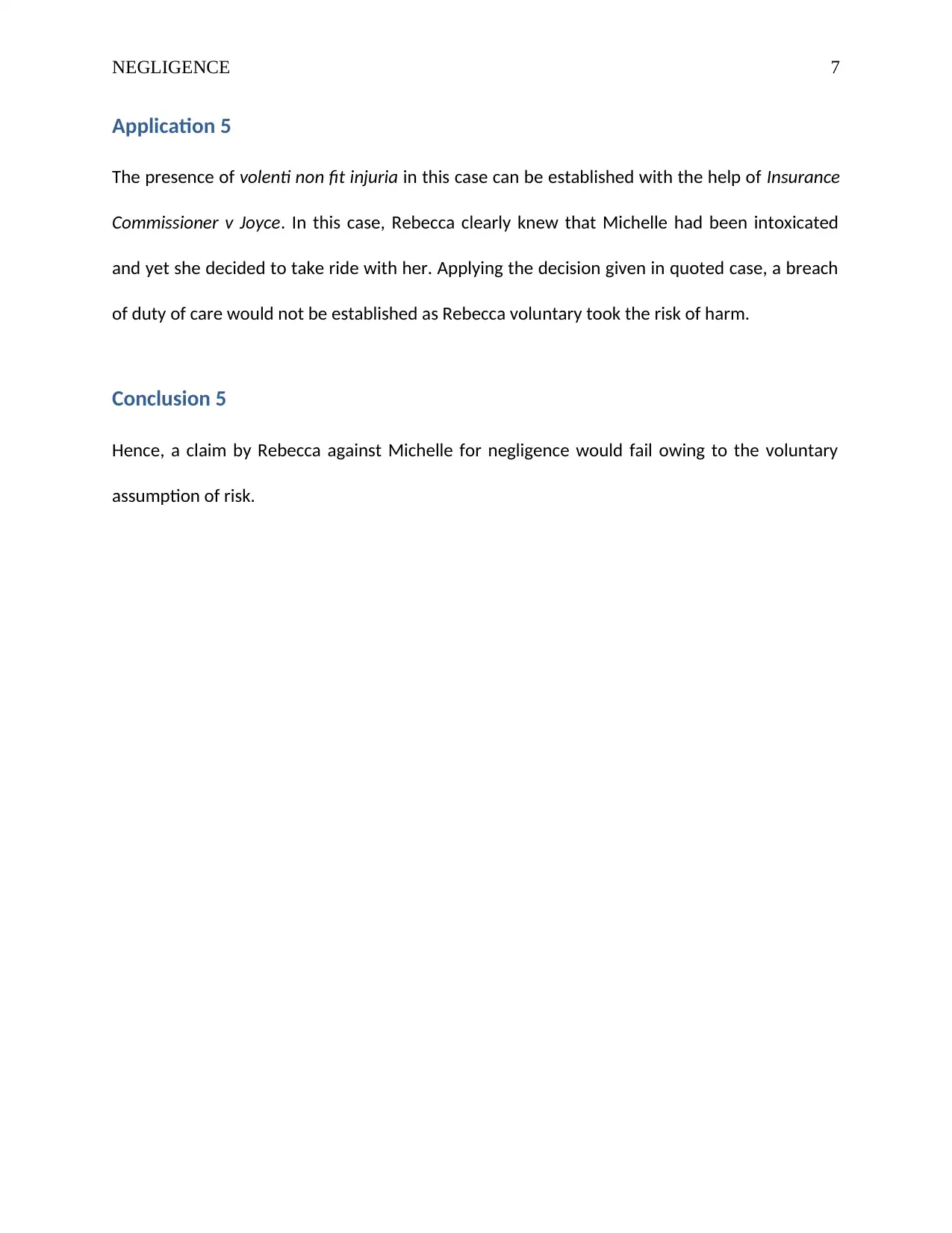
NEGLIGENCE 7
Application 5
The presence of volenti non fit injuria in this case can be established with the help of Insurance
Commissioner v Joyce. In this case, Rebecca clearly knew that Michelle had been intoxicated
and yet she decided to take ride with her. Applying the decision given in quoted case, a breach
of duty of care would not be established as Rebecca voluntary took the risk of harm.
Conclusion 5
Hence, a claim by Rebecca against Michelle for negligence would fail owing to the voluntary
assumption of risk.
Application 5
The presence of volenti non fit injuria in this case can be established with the help of Insurance
Commissioner v Joyce. In this case, Rebecca clearly knew that Michelle had been intoxicated
and yet she decided to take ride with her. Applying the decision given in quoted case, a breach
of duty of care would not be established as Rebecca voluntary took the risk of harm.
Conclusion 5
Hence, a claim by Rebecca against Michelle for negligence would fail owing to the voluntary
assumption of risk.
Paraphrase This Document
Need a fresh take? Get an instant paraphrase of this document with our AI Paraphraser
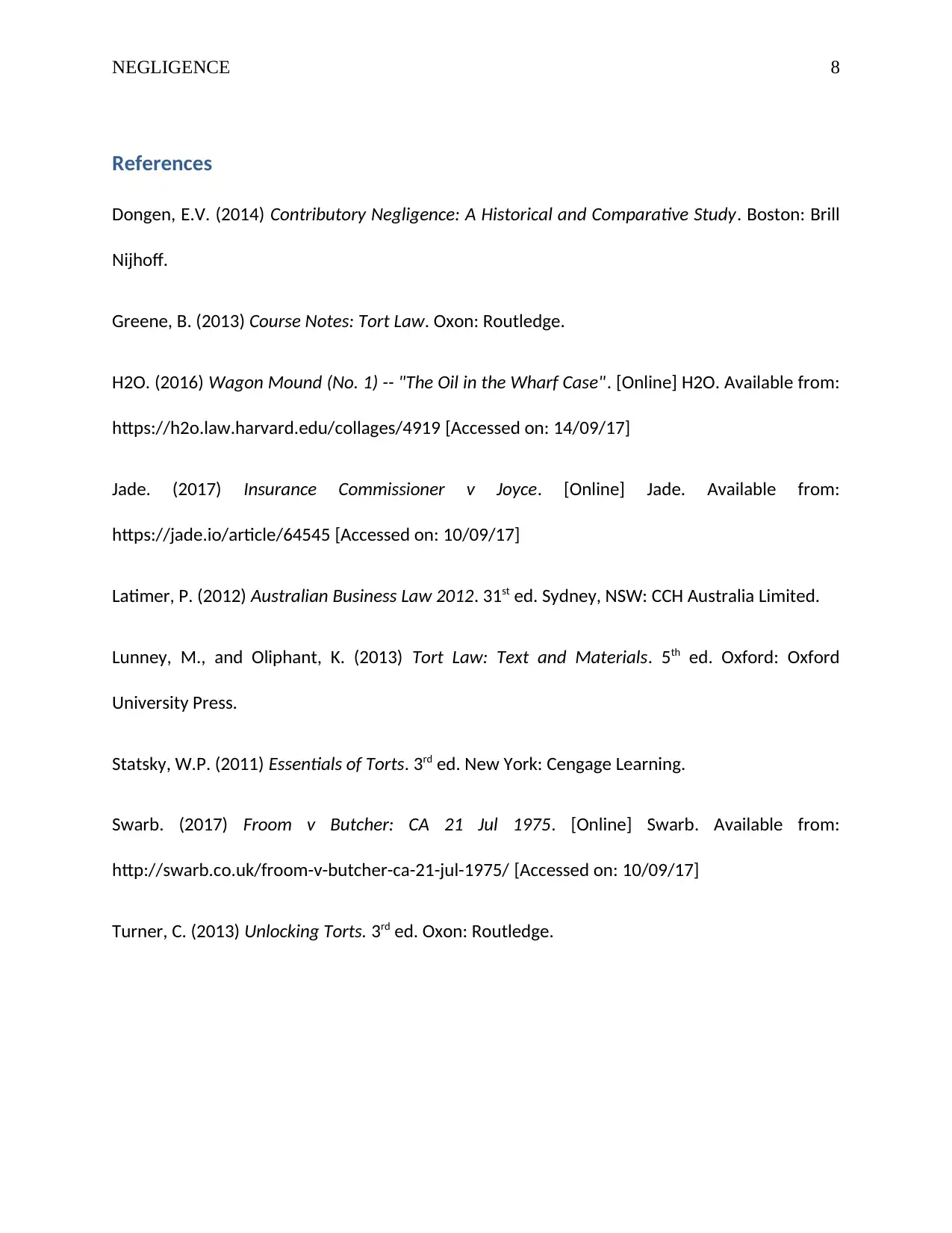
NEGLIGENCE 8
References
Dongen, E.V. (2014) Contributory Negligence: A Historical and Comparative Study. Boston: Brill
Nijhoff.
Greene, B. (2013) Course Notes: Tort Law. Oxon: Routledge.
H2O. (2016) Wagon Mound (No. 1) -- "The Oil in the Wharf Case". [Online] H2O. Available from:
https://h2o.law.harvard.edu/collages/4919 [Accessed on: 14/09/17]
Jade. (2017) Insurance Commissioner v Joyce. [Online] Jade. Available from:
https://jade.io/article/64545 [Accessed on: 10/09/17]
Latimer, P. (2012) Australian Business Law 2012. 31st ed. Sydney, NSW: CCH Australia Limited.
Lunney, M., and Oliphant, K. (2013) Tort Law: Text and Materials. 5th ed. Oxford: Oxford
University Press.
Statsky, W.P. (2011) Essentials of Torts. 3rd ed. New York: Cengage Learning.
Swarb. (2017) Froom v Butcher: CA 21 Jul 1975. [Online] Swarb. Available from:
http://swarb.co.uk/froom-v-butcher-ca-21-jul-1975/ [Accessed on: 10/09/17]
Turner, C. (2013) Unlocking Torts. 3rd ed. Oxon: Routledge.
References
Dongen, E.V. (2014) Contributory Negligence: A Historical and Comparative Study. Boston: Brill
Nijhoff.
Greene, B. (2013) Course Notes: Tort Law. Oxon: Routledge.
H2O. (2016) Wagon Mound (No. 1) -- "The Oil in the Wharf Case". [Online] H2O. Available from:
https://h2o.law.harvard.edu/collages/4919 [Accessed on: 14/09/17]
Jade. (2017) Insurance Commissioner v Joyce. [Online] Jade. Available from:
https://jade.io/article/64545 [Accessed on: 10/09/17]
Latimer, P. (2012) Australian Business Law 2012. 31st ed. Sydney, NSW: CCH Australia Limited.
Lunney, M., and Oliphant, K. (2013) Tort Law: Text and Materials. 5th ed. Oxford: Oxford
University Press.
Statsky, W.P. (2011) Essentials of Torts. 3rd ed. New York: Cengage Learning.
Swarb. (2017) Froom v Butcher: CA 21 Jul 1975. [Online] Swarb. Available from:
http://swarb.co.uk/froom-v-butcher-ca-21-jul-1975/ [Accessed on: 10/09/17]
Turner, C. (2013) Unlocking Torts. 3rd ed. Oxon: Routledge.
1 out of 8
Related Documents
Your All-in-One AI-Powered Toolkit for Academic Success.
+13062052269
info@desklib.com
Available 24*7 on WhatsApp / Email
![[object Object]](/_next/static/media/star-bottom.7253800d.svg)
Unlock your academic potential
Copyright © 2020–2025 A2Z Services. All Rights Reserved. Developed and managed by ZUCOL.





